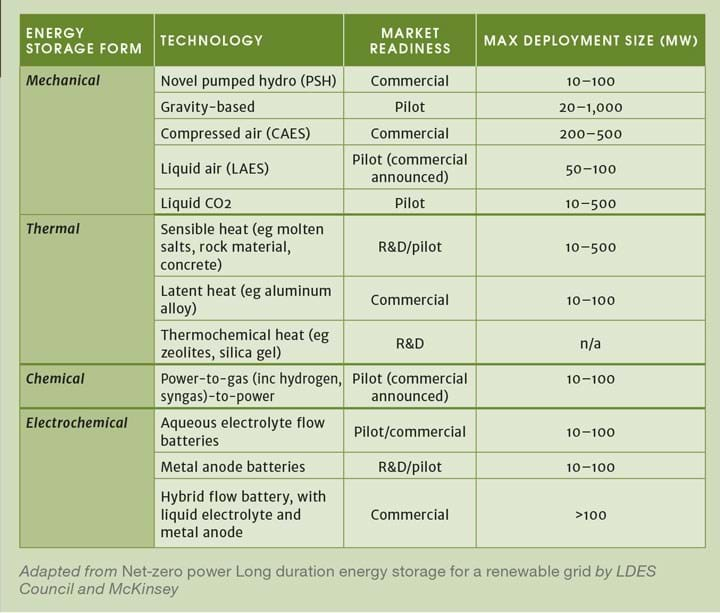Energy: How to Store It

Adam Duckett looks at promising energy storage options that could help balance the rise of renewables
WITH renewable energy on the rise and a fresh warning that the power grid could soon be oversupplied for most of the year, we need energy storage technologies to smooth our spikier future of supply and demand.
Last year, the growth in renewables capacity increased by 9% adding 3,064 GW of capacity. Renewables was responsible for 81% of expanded capacity in 2021. It grew to 38.2% of global generation capacity compared to 36.6% the year before. While the increase is encouraging, Francesco La Camera, Director-General of the International Renewable Energy Agency (IRENA), said the data “shows that the energy transition is far from being fast or widespread enough to avert the dire consequences of climate change.”
While too slow in respect of the climate, the projected pace of growth could prove too fast for the UK. The consultancy LCP warned in May that based on the generation capacity that the UK Government outlined in its new energy strategy, by 2030 the electricity grid will experience an oversupply of renewable and nuclear power for 53% of the hours in the year. For comparison it expects an oversupply for 6% of the time during 2022.
“To tackle this significant oversupply, the UK needs to accelerate the delivery of demand-side flexibility to capture this spare energy and ensure it doesn’t go to waste. This can be through fast-growing technologies such as battery storage, longer-term storage such as pumped hydro, as well as the electrolysers to produce hydrogen for use in other energy markets such as heating,” said LCP Partner Chris Matson.
Of course, it’s not just a UK headache. Engineers around the globe face the challenge and opportunity of developing systems for balancing intermittent supply with demand, stabilising grids and ensuring that renewable generators can profitably sell their power
What storage options do we have?
There are many approaches for classifying the different methods of storing and releasing energy. Broadly speaking they fall into four categories: mechanical, thermal, chemical or electrochemical.
The most common form of energy storage used today is pumped storage hydropower (PSH). This is a form of mechanical energy storage that involves using surplus power to pump water uphill. The water is then released downhill to generate power when demand requires. The IEA estimates that pumped storage hydropower is responsible for more than 95% of global energy storage capacity today with more than 8,400 GWh.
Next, lagging way behind with around 22 GWh is concentrated solar power. An array of technologies are available but typically this involves using mirrors to focus sunlight onto a receiver tower to heat the fluids cycling inside. A common example is molten salts which can be stored in tanks and then passed through a heat exchanger to generate steam for use as process heat for industry or a turbine for power. This allows solar to provide energy even during the night, though application of the technology is limited to very sunny countries, and plants have very large footprints.
And then third in the IEA’s list are batteries – an electrochemical means of storage – with just over 19 GWh.
In November, industry and technology developers including BP, Rio Tinto, Alfa Laval and Microsoft formed the Long Duration Energy Storage Council and set a target to help deploy 85-140 TWh of energy storage by 2040. A report by the group outlined the market readiness of some of the more nascent technologies (see Table 1). Let’s look at a selection of projects that are currently in the works.

Novel pumped hydro
As mentioned above, PSH accounts for the vast majority of energy storage capacity in use today but is limited to hilly, spacious areas that are available to host large reservoirs of water. To get around this, or rather under it, there are novel forms of PHS in development.
In March, Quidnet Energy signed an agreement to build up to a 15 MW project in the US that involves pumping water into a closed loop network between rock layers. When power is required, the well is opened to let the pressurised water pass through a turbine and return to a pond on the surface. The company, which is backed with funding from Bill Gates, notes that its solution builds on existing skills and technology used in the oil and gas industry so provides a route for engineers and technicians to move into greener industries.
There’s also considerable interest in using abandoned mines for PSH. This would involve pumping water between different levels of an underground mine, or from the mine to a reservoir on the surface. In December, a consortium led by the company Mine Storage said they are planning an underground facility in Sweden’s historical mining area of Bergslagen. The consortium said there are an estimated 1m abandoned mines across the world that could contribute to a green transition.
Or, there’s the approach of UK company RheEnergise which wants to open up PSH to lower hills by using a fluid that is two and a half times denser than water. It estimates there are 700 suitable sites in the UK and if just half were used it could provide 7 GW of energy storage in the UK. In February, the UK Government granted RheEnergise £150,000 from its Longer Duration Energy Storage Demonstration Programme to deliver a feasibility study on its technology.
By 2030 the electricity grid will experience an oversupply of renewable and nuclear power for 53% of the hours in the year
Potential of gravity
What if you have no mines and no hills for pumping water? Then Energy Vault’s gravity-based system could be the answer. The company has developed an eye-catching solution involving cranes that use surplus power to lift heavy weights. When power is needed, the weights are dropped. In 2020 it connected a 35 MWh demonstration unit to the Swiss national grid. It has since gone public and taken orders for a 100 MWh system in China and 1.6 GWh across North America.
It has also signed a partnership with Korea Zinc to help decarbonise its refining operations and use its tailings and refining waste materials to make the storage project’s heavy blocks.
Meanwhile, UK firm Gravitricity is proposing raising and dropping weights down disused mine shafts or purpose built shafts. It has received close to £1m from the UK Government to design a multiweight demonstrator in northern England.

Recent Editions
Catch up on the latest news, views and jobs from The Chemical Engineer. Below are the four latest issues. View a wider selection of the archive from within the Magazine section of this site.




